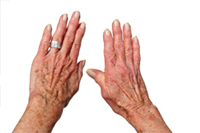Osteoarthritis – Causes, Symptoms, Treatments
|
Reading time: 10 minutes
|

Key Takeaways
- Osteoarthritis (OA) is the primary type of arthritis, affecting joints through cartilage breakdown.
- OA affects over 32.5 million adults in the US, with higher risks in women and older individuals due to age-related joint wear.
- OA involves gradual cartilage breakdown, leading to joint pain, stiffness, and bone changes like osteophyte formation.
- Symptoms include joint pain, stiffness after rest, swelling, and reduced mobility, impacting daily activities and quality of life.
- Diagnosis involves symptoms review, physical examination, and imaging like X-rays, managed through exercise, weight control, and medications for pain relief.
What is Osteoarthritis?
Osteoarthritis (OA) is the most common form of arthritis. It is a degenerative joint disease that can affect any joint in the body, but it most commonly affects the hands, hips, and knees.
Osteoarthritis occurs when the cartilage that cushions and protects the ends of your bones breaks down. This can cause pain, stiffness, swelling, and decreased range of motion in the affected joint. It is estimated that more than 32.5 million adults in the United States have OA according to the Centers for Disease Control and Prevention (CDC).
Studies also suggest that OA is more common in women than in men, with the risk of experiencing osteoarthritis increasing with age.
Osteoarthritis (OA) being a degenerative joint disease means the condition is characterized by the breakdown and degeneration of the tissues within a joint, primarily the cartilage. This breakdown happens gradually over time, often due to wear and tear.
- Cartilage Breakdown: The initial stage involves the breakdown of the smooth hyaline cartilage that cushions the ends of bones within a joint. This cartilage acts like a shock absorber, distributing pressure evenly and allowing for smooth, pain-free movement. Several factors can contribute to this breakdown, including age-related degeneration, repetitive stress on the joint, and previous injuries. As the cartilage thins and loses its integrity, it becomes less effective in protecting the underlying bone.
- Joint Stress and Inflammation: With the loss of the protective cartilage layer, the underlying bone becomes exposed, leading to increased friction and stress within the joint. This stress can cause microfractures in the bone, further damaging the joint and triggering inflammation. The body’s inflammatory response sends immune cells to the area, leading to pain, stiffness, and swelling. This inflammation can also damage the synovium, the thin membrane lining the joint that produces lubricating fluid.
- Bone Changes: Over time, the body attempts to repair the damage by forming bony growths (osteophytes) around the edges of the joint. These osteophytes, commonly referred to as bone spurs, may appear in an attempt to stabilize the joint. However, they can ironically contribute to further limitations in movement and impingement on surrounding tissues.
- Joint Deformity: In advanced stages of osteoarthritis, the ongoing breakdown of cartilage, inflammation, and bone changes can significantly alter the joint structure. This can lead to visible deformity of the joint, such as bowing in the legs or knobby finger joints. The deformity can further restrict movement and cause additional pain.
- Muscle Weakness and Instability: The pain and stiffness associated with OA can lead to disuse and weakening of the muscles surrounding the affected joint. This muscle weakness can contribute to joint instability, increasing the risk of falls and further injuries.
Risk Factors of Osteoarthritis
The breakdown of cartilage in osteoarthritis (OA) sets off a chain reaction that can lead to pain, inflammation, bone spurs, stiffness, and limited joint function.
- Joint Injuries: Past injuries, like torn ligaments or meniscus tears, can increase the risk of OA developing in that joint later.
- Obesity: Excess weight puts extra stress on weight-bearing joints like knees and hips, accelerating cartilage breakdown.
- Genetics: Some people are genetically predisposed to having weaker cartilage, making them more susceptible to OA.
- Joint Abnormalities: People with misaligned joints or congenital defects in their joint structure are more likely to develop OA earlier and experience more severe symptoms.
- Other Joint Diseases: Certain conditions like rheumatoid arthritis or gout can damage the joints and contribute to secondary OA.
Symptoms and Complications of Osteoarthritis
Osteoarthritis (OA) can slowly chip away at your joints, bringing on a set of symptoms that worsen over time. One of the earliest signs is usually pain in the affected joint. This pain often flares up during or after activities that put stress on the joint, like climbing stairs or walking for extended periods. Initially, stiffness might also plague the joint, particularly after periods of rest, but it usually eases with movement.
As OA progresses, the pain might become more frequent and intense, even occurring at rest. The stiffness can worsen, taking longer to loosen up and potentially limiting your range of motion in the joint. Some people experience swelling around the joint, and a sensation of grinding or grating when they move it, which is caused by the bones rubbing against each other due to the worn-down cartilage.
These worsening symptoms can significantly impact daily activities. Simple tasks like getting dressed, crouching down, or climbing stairs can become difficult and even painful. Daily walks might be cut short due to joint pain, and physical hobbies or sports that were once enjoyable may become too uncomfortable to participate in. This decline in mobility can lead to frustration and a decrease in overall quality of life.
In severe cases of OA, the constant friction within the joint can lead to bony growths developing around the edges. This further restricts movement and can cause the joint to become visibly deformed. OA can also affect your sleep quality, as pain and stiffness can make it difficult to get comfortable at night. The condition can take a toll on your mental well-being as well, with some people experiencing anxiety or depression due to chronic pain and limitations in their activities.
Which Joints are Most Affected by Osteoarthritis?
While osteoarthritis (OA) can technically affect any joint in the body, some joints are significantly more prone to the wear and tear that characterizes this condition.
- Weight-bearing joints: These joints bear the brunt of your body weight and constant movement throughout the day, making them more susceptible to OA over time. This includes the knees, hips, and lower back (spine). Knee OA is particularly common, often causing pain and stiffness that hinders activities like walking, climbing stairs, and squatting.
- Hands: The small joints in the fingers and thumbs are frequently affected by OA, especially in older adults. This can lead to painful nodules forming around the joints, making it difficult to grasp objects or perform everyday tasks like buttoning clothes or writing.
- Neck and upper back: The facet joints in the spine, which connect the vertebrae, can develop OA. This can cause neck pain, stiffness, and headaches.
How is Osteoarthritis diagnosed?
Diagnosing osteoarthritis (OA) often involves a combination of methods to get a complete picture.
Your doctor will first discuss your symptoms in detail. This might include questions about the location of pain, its intensity, when it occurs (during activity, at rest, etc.), and any factors that worsen or improve the pain. They’ll also inquire about your past injuries, overall health, and family history, as certain factors can increase the risk of OA.
The doctor will then physically examine the affected joint(s). This involves checking for tenderness, swelling, redness, and warmth around the joint. They will also assess your range of motion by gently moving the joint and testing for any creaking or grinding sensations. This examination helps differentiate OA from other conditions that might cause joint pain.
X-ray imaging tests are the main standard for diagnosis. While X-rays can’t directly visualize cartilage, they can reveal narrowing of the joint space (a sign of cartilage loss) and the presence of bone spurs, which are strong indicators of OA.
MRI (Magnetic Resonance Imaging), while not routinely used for initial diagnosis, can provide a more detailed picture of the joint. It can show not only bone structure but also soft tissues like cartilage and ligaments. This can be helpful in identifying subtle cartilage damage or ruling out other causes of joint pain, like injuries or infections.
In some cases, your doctor might aspirate fluid from the affected joint using a needle. Analysis of this fluid can differentiate between OA, which typically shows minimal inflammatory cells, and inflammatory arthritis like rheumatoid arthritis, which shows a higher white blood cell count.
How is Osteoarthritis Treated?
There isn’t a cure for osteoarthritis (OA), but there are various treatment strategies aimed at managing pain, improving joint function, and slowing the progression of the condition. Here’s an overview of the common approaches:
Non-medicinal treatments:
- Exercise: Regular physical activity strengthens muscles that support the joints, improves flexibility, and can help reduce pain and stiffness. Low-impact exercises like walking, swimming, and water aerobics are often recommended.
- Weight management: Maintaining a healthy weight takes pressure off weight-bearing joints like knees and hips, which can significantly reduce pain and improve mobility.
- Physical therapy: A physical therapist can design a personalized exercise program to strengthen muscles, improve flexibility, and teach proper joint movement techniques to ease pain and maintain function.
- Heat and cold therapy: Applying heat or cold packs to the affected joint can help manage pain and inflammation. Heat is often used for stiffness, while cold therapy can be helpful for reducing inflammation after activity.
- Assistive devices: Using canes, walkers, or braces can provide support and stability to the joints, reducing stress and pain during daily activities.
Medications:
- Over-the-counter pain relievers: Medications like acetaminophen (Tylenol) or nonsteroidal anti-inflammatory drugs (NSAIDs) like ibuprofen or naproxen can help manage pain and inflammation.
- Prescription medications: In some cases, stronger pain relievers or topical medications might be prescribed. Additionally, medications like hyaluronic acid injections can be used in specific situations to lubricate the joint and potentially reduce pain.
Joint Procedures (in severe cases):
- Cortisone injections: These injections deliver a corticosteroid medication directly into the inflamed joint to provide a powerful but temporary reduction in pain and inflammation.
- Joint replacement surgery: When conservative measures fail to provide adequate pain relief and significantly limit mobility, joint replacement surgery might be considered. This surgery involves replacing the damaged joint with a prosthetic implant.
What Medications are Most Often Prescribed for Osteoarthritis?
- Analgesics (Pain Relievers): Acetaminophen (Tylenol) is often recommended as a first-line medication for mild to moderate pain associated with OA. It helps alleviate pain without causing inflammation. Nonsteroidal anti-inflammatory drugs (NSAIDs) like ibuprofen (Advil, Motrin) and naproxen (Aleve) are also commonly prescribed to reduce pain and inflammation.
- Topical Analgesics: These are applied directly to the skin over the affected joint and can provide localized pain relief. Examples include topical NSAIDs (e.g., diclofenac gel) and capsaicin cream.
- Corticosteroids: Corticosteroid injections into the affected joint can provide significant pain relief and reduce inflammation, particularly for OA in the knee or hip. However, their long-term use may have adverse effects on joint health.
- Hyaluronic Acid Injections: These injections aim to provide lubrication and cushioning to the joint, potentially reducing pain and improving joint function. They are commonly used for knee OA.
- Duloxetine: This medication is a serotonin-norepinephrine reuptake inhibitor (SNRI) that is sometimes prescribed for OA pain, particularly when other pain medications are not effective. It can help relieve both pain and depression associated with OA.
- Tramadol: Tramadol is an opioid analgesic that may be prescribed for moderate to severe OA pain when other medications are not effective or tolerated. However, it carries a risk of dependence and should be used with caution.
- Disease-Modifying Osteoarthritis Drugs (DMOADs): These are a newer class of medications being researched for their potential to slow the progression of OA. Examples include glucosamine and chondroitin sulfate, although their effectiveness is still debated.
Information provided on this website is for general purposes only. It is not intended to take the place of advice from your practitioner







